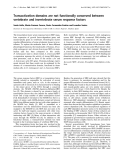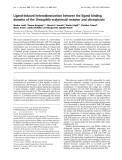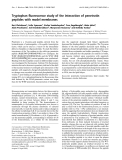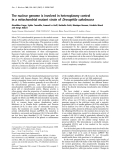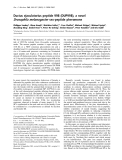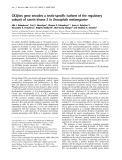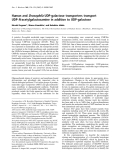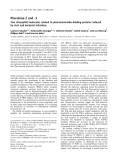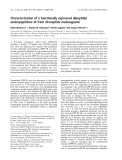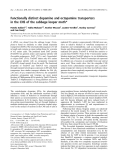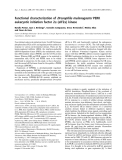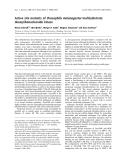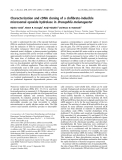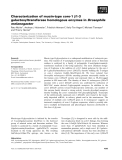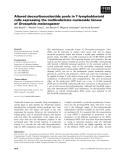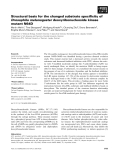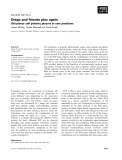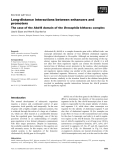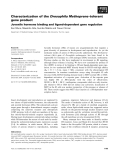
Drosophila
-
The transcription factor serum response factor (SRF) regulates expression of growth factor-dependent genes and muscle-specific genes in vertebrates. Homologous factors regulate differentiation of some ectodermic tissues in invertebrates. To explore the molecular basis of these different physiological functions, the functionality of human, Drosophila melanogaster and Artemia franciscana SRFs in mammalian cells has been compared in this article. D. melanogaster and, to a lesser extend, A.
 9p
9p  system191
system191
 01-06-2013
01-06-2013
 34
34
 5
5
 Download
Download
-
The insect ecdysteroid receptor consists of a heterodimer between EcR and the RXR-orthologue, USP. We addressed the question of whether this heterodimer, like all other RXR heterodimers, may be formed in the absence of ligand and whether ligand promotes dimerization. We found that C-terminal protein fragments that comprised the ligand binding, but not the DNA binding domain of EcR and USP and which were equipped with the activation or DNA binding region of GAL4, respectively, exhibit a weak ability to interact spontaneously with each other.
 9p
9p  system191
system191
 01-06-2013
01-06-2013
 30
30
 3
3
 Download
Download
-
Laboratory for Lipoprotein Chemistry and 4Flanders Interuniversity Institute for Biotechnology, Department of Medical Protein Research, Faculty of Medicine, Department of Biochemistry, Ghent University, Belgium; 2Laboratory of Biomolecular Dynamics, Katholieke Universiteit Leuven, Belgium; 3Ecole Normale Supe´rieure, Paris, France Penetratin is a 16-amino-acid peptide, derived from the homeodomain of antennapedia, a Drosophila transcription factor, which can be used as a vector for the intracellular delivery of peptides or oligonucleotides....
 9p
9p  system191
system191
 01-06-2013
01-06-2013
 33
33
 4
4
 Download
Download
-
Most (78%) mitochondrial genomes in the studied mutant strain of Drosophila subobscura have undergone a large-scale deletion (5 kb) in the coding region. This mutation is stable, and is transmitted intact to the offspring. This animal model of major rearrangements of mitochondrial genomes can be used to analyse the involvement of the nuclear genome in the production and maintenance of these rearrangements.
 8p
8p  research12
research12
 01-06-2013
01-06-2013
 52
52
 6
6
 Download
Download
-
We have characterized a glycosylated, 31 amino-acid peptide of 4932 Da isolated from Drosophila melanogaster males. The mature peptide contains a sugar moiety of 1184 Da at a NDT consensus glycosylation site and a disulfide bond. It is synthesized in the male ejaculatory duct via a 54 amino-acid precursor containing an N-terminal signal peptide and Arg-Lys at the C-terminus which is cleaved off during maturation. The gene contains an intron of 53 bp and is localized in the cytological region 99B of the D. melanogaster genome....
 9p
9p  research12
research12
 01-06-2013
01-06-2013
 41
41
 4
4
 Download
Download
-
An earlier described CK2btes gene of Drosophila melano-gasteris shown to encode amale germline speci®c isoformof regulatory bsubunit of casein kinase 2. Western-analysis using anti-CK2btes Ig revealed CK2btes protein in Drosophila testes extract. Expression of a CK2btes± b-galactosidase fusion protein driven by the CK2btes pro-moter was found in transgenic ¯ies at postmitotic stages of spermatogenesis.
 10p
10p  research12
research12
 29-04-2013
29-04-2013
 31
31
 4
4
 Download
Download
-
A putativeDrosophilanucleotide sugar transporter was characterized and shown to be theDrosophilahomologue of the human UDP-Gal transporter (hUGT). When the Drosophila melanogasterUDP-Gal transporter (DmUGT) was expressed in mammalian cells, the transporter protein was localized in the Golgi membranes and complemented the UDP-Gal transport de®ciency of Lec8 cells but not the CMP-Sia transport de®ciency of Lec2 cells.
 11p
11p  research12
research12
 29-04-2013
29-04-2013
 31
31
 2
2
 Download
Download
-
Themosquito,Anopheles gambiae, is an important vector of Plasmodium falciparum malaria. Full genome analysis revealed that, as in Drosophila melanogaster,the enzyme glutathione reductase is absent inA. gambiaeand func-tionally substituted by the thioredoxin system. The key enzyme of this system is thioredoxin reductase-1, a homo-dimeric FAD-containing protein of 55.3 kDa per subunit, which catalyses the reaction NADPH + H + + thio-redoxin disulfidefiNADP + + thioredoxin dithiol.
 10p
10p  tumor12
tumor12
 20-04-2013
20-04-2013
 31
31
 3
3
 Download
Download
-
Drosophilais a powerful model system to study the regula-tory and effector mechanisms of innate immunity. To iden-tify molecules induced in the course of viral infection in this insect, we have developed a model based on intrathoracic injection of the picorna-like DrosophilaCvirus(DCV).We have used MALDI-TOF mass spectrometry to compare the hemolymph of DCV infected flies and control flies. By contrast with the strong humoral response triggered by injectionof bacteriaor fungal spores, we have identifiedonly one molecule induced in the hemolymph of virus infected flies....
 10p
10p  tumor12
tumor12
 20-04-2013
20-04-2013
 27
27
 3
3
 Download
Download
-
A Drosophila melanogaster cDNA clone (GH01916) encoding a putative 723-residue long (82 kDa) protein (CG 7415) and displaying 50% identity with mammalian cytosolic dipeptidyl aminopeptidase (DPP) III was func-tionally expressed in Schneider S2 cells. Immunocytochemi-cal studies using anti-(rat liver DPP III) Ig indicated the expression of this putative DPP III at the outer cell mem-brane and into the cytosol of transfected cells.
 9p
9p  tumor12
tumor12
 20-04-2013
20-04-2013
 37
37
 3
3
 Download
Download
-
A cDNA was cloned from the cabbage looperTricho-plusia ni based on similarity to other cloned dopamine transporters (DATs). The total nucleotide sequence is 3.8kb in length and contains an open reading frame for a protein of 612 amino acids. The predicted moth DAT protein (TrnDAT) has greatest amino acid sequence identity with Drosophila melanogasterDAT (73%) andCaenorhabdi-tis elegans DAT (51%). TrnDAT shares only 45% amino acid sequence identity with an octopamine transporter (TrnOAT) cloned recently from this moth. ...
 11p
11p  tumor12
tumor12
 20-04-2013
20-04-2013
 45
45
 3
3
 Download
Download
-
Four distinct eukaryotic initiation factor 2a(eIF2a)kinases phosphorylate eIF2aat S51and regulateprotein synthesis in response to various environmental stresses. These are the hemin-regulated inhibitor (HRI), the interferon-inducible dsRNA-dependent kinase (PKR), the endoplasmic reticu-lum (ER)-resident kinase (PERK) and the GCN2 protein kinase. Whereas HRI and PKR appear to be restricted to mammalian cells, GCN2 and PERK seem to be widely distributed in eukaryotes.
 14p
14p  tumor12
tumor12
 20-04-2013
20-04-2013
 29
29
 4
4
 Download
Download
-
The multisubstrate deoxyribonucleoside kinase ofDroso-phila melanogaster (Dm-dNK) is sequence-related to three human deoxyribonucleoside kinases and to herpes simplex virus type-1 thymidine kinase. Dm-dNK phos-phorylates both purine and pyrimidine deoxyribonucleo-sides and nucleoside analogues although it has a preference for pyrimidine nucleosides. We performed site-directed mutagenesis on residues that, based on structural data, are involved in substrate recognition.
 6p
6p  fptmusic
fptmusic
 16-04-2013
16-04-2013
 37
37
 3
3
 Download
Download
-
In order to understand the roles of the epoxide hydrolases (EHs) in xenobiotic biotransformation in insects, we exam-ined the induction of EHs by exogenous compounds in Drosophila melangasterthird instar larvae. Among the chemicals tested, clofibrate, a phenoxyacetate hypolipider-mics drug, increased EH activity towardscis-stilbene oxide approximately twofold in larval whole-body homogenates. The same dose of clofibrate also induced glutathione S-transferase activity.
 10p
10p  fptmusic
fptmusic
 12-04-2013
12-04-2013
 37
37
 2
2
 Download
Download
-
Mucin type O-glycosylation is a widespread modification of eukaryotic pro-teins. The transfer of N-acetylgalactosamine to selected serine or threonine residues is catalyzed by a family of polypeptide N-acetylgalactosaminyl-transferases localized in the Golgi apparatus. The most abundant elonga-tion of O-glycans is the addition of a b1-3 linked galactose by the core-1 b1-3 galactosyltransferase (core-1b3GalT), thereby building the T-antigen or core-1 structure Gal(b1-3)GalNAc(a1-O).
 11p
11p  fptmusic
fptmusic
 11-04-2013
11-04-2013
 35
35
 4
4
 Download
Download
-
The multisubstrate nucleoside kinase of Drosophila melanogaster(Dm-dNK) can be expressed in human solid tumor cells and its unique enzymatic properties makes this enzyme a suicide gene candidate. In the present study,Dm-dNK was stably expressed in the CCRF-CEM and H9 T-lymphoblastoid cell lines. The expressed enzyme was localized to the cell nucleus and the enzyme retained its activity.
 11p
11p  fptmusic
fptmusic
 11-04-2013
11-04-2013
 41
41
 2
2
 Download
Download
-
TheDrosophila melanogasterdeoxyribonucleoside kinase (Dm-dNK) double mutant N45D⁄N64D was identified during a previous directed evolution study. This mutant enzyme had a decreased activity towards the natural substrates and decreased feedback inhibition with dTTP, whereas the activ-ity with 3¢-modified nucleoside analogs like 3¢-azidothymidine (AZT) was nearly unchanged.
 10p
10p  fptmusic
fptmusic
 11-04-2013
11-04-2013
 34
34
 3
3
 Download
Download
-
The formation of properly differentiated organs often requires the planar coordination of cell polarization within the tissues. Such planar cell polar-ization (PCP) events are best studied in Drosophila, where many of the key players, known as PCP genes, have already been identified. Genetic analy-sis of the PCP genes suggests that the establishment of polarity consists of three major steps.
 12p
12p  fptmusic
fptmusic
 11-04-2013
11-04-2013
 37
37
 3
3
 Download
Download
-
Abdominal-B(Abd-B) is a complex homeotic gene with a difficult task: one transcript determines the identity of four different abdominal segments throughout development in Drosophila.
 7p
7p  fptmusic
fptmusic
 11-04-2013
11-04-2013
 38
38
 2
2
 Download
Download
-
Juvenile hormones (JHs) of insects are sesquiterpenoids that regulate a great diversity of processes in development and reproduction. As yet the molecular modes of action of JH are poorly understood. TheMethoprene-tolerant (Met) gene of Drosophila melanogasterhas been found to be responsible for resistance to a JH analogue (JHA) insecticide, methoprene. Previous studies onMethave implicated its involvement in JH signaling, although direct evidence is lacking.
 0p
0p  awards
awards
 05-04-2013
05-04-2013
 33
33
 1
1
 Download
Download
CHỦ ĐỀ BẠN MUỐN TÌM









